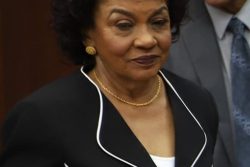With a financing shortfall of $3.5B-$4B likely this year, the power company says it faces four options: a tariff hike, load shedding at peak hours, more cash support from the government and increased conservation.
Speaking at a press conference yesterday at the company’s boardroom in Middle Street, Chairman of the Guyana Power and Light (GPL) Winston Brassington said that depending on the fuel situation, the company could very soon implement one or more of these measures.
The company last had an increase in tariffs at the beginning of the year at rates varying from 6 per cent to 20 per cent.
He pointed out that Government is supporting GPL’s capital programme to increase the total use of HFO (Heavy Fuel Oil) which is cheaper than diesel.
“Between 2007 and 2008, total funding will exceed US$30M. In addition, Government is paying a higher rate increase to cushion the impact on customers. GPL is also seeking to maximise the level of efficiencies to reduce costs,” he said.
“GPL’s problem is therefore the immediate to short term. How to bridge the increased fuel costs based on rising prices. When the above capital projects are completed, the current fuel bill at current prices of $2 billion per month ($24 billion per annum) will drop to $1.6 billion per month ($19.5 billion per annum), an annual saving of over $4.5 billion,” Brassington stated.
He said that the company therefore seeks to engage customers on how to address the current financial gap that is projected at approximately $3.5 billion to $4 billion to the end of the year, based on current prices.
Clearing the air on a recent GPL press release, Brassington said that the release highlighted the need for customers to conserve energy because of the high fuel prices. “The press release did not state that GPL is considering increasing tariffs and any recent insinuation in the media would be speculation,” Brassington said.
But he added that the company has already submitted information on its fuel purchases this year to the Public Utilities Commission (PUC) “for information purposes.”
Brassington said that in 2008, the company budgeted fuel purchases at US$85M based on a CIF price of HFO at US$83 per barrel and diesel at US$119 per barrel. “With a fuel mix based on volume of 62 per cent HFO and 38 per cent diesel, the weighted average price was US$96 per barrel. In US$ value terms, this amounted to US$50M (59 per cent of total for HFO and US$35M (41 per cent of total) for diesel. He said too that this price was roughly on par with the world market prices of crude oil at the end of December of US$95 per barrel.
He said that at the current time, GPL faces prices of US$100 (CIF) per barrel of HFO – a 26 per cent increase over the budgeted price of US$83 per barrel – and US$172 (CIF) per barrel for diesel – 44 per cent over the budgeted price of US$119 per barrel. He said that at current fuel prices the monthly fuel bill exceeds the company’s sales.
Brassington said that one key factor in determining GPL finances is the effect of the daily peak and the benefits of conservation. “GPL increment cost of generation is the cost of diesel generation at a price of US$172 per barrel versus US$119 per barrel. The differential of over US$50 per barrel has considerable financial implications,” he said, adding that as the peak usage falls, the company uses less diesel while as the peak rises more diesel is used.
Brassington explained that in the first four months of 2008, the company has seen some results in its conservation efforts and the maximisation of usage of HFO. He said that through the capital investments that GPL is making with the assistance of the Government of Guyana, the company should be generating about 95 per cent of its power through HFO.
Brassington pointed out that for the first four months of this year, GPL has been able to maximize its use of HFO compared to diesel. However, he listed a number of factors which could affect this mix including the daily peak. Another was the scheduled availability of HFO machines – the eight 5.5 MW sets in Demerara are undergoing scheduled overhauls. One occurred in April and four more are expected during the rest of the year. In addition, the Guysuco HFO plant has been unavailable since April 11 but should be back in service this week with 10 MW. GPL can take a maximum of 8 MW of this at peak and this will improve when the 69 KV transmission line is completed in the first quarter of next year.
HFO capacity is also scheduled to improve with a planned new 20 MW Wartsila facility at Kingston, completion of the biofuel bagasse plant and 10 MW of HFO at Canefield via acquisition/conversion. Another factor affecting the mix is the location of demand in Berbice and Demerara since GPL cannot move any significant amount of power between the two counties.
Questioned on losses, Company CEO Bharat Dindyal said that losses are in the vicinity of 34 per cent of generation. But he said that the bulk of this has to do with faulty meters, theft of electricity and billing faults. He said that over $2 billion is lost to theft on a yearly basis. He said that media attention is generally on un-metered areas when thefts occur, but he said that the company will place more emphasis on theft among metered consumers. To this end, he reminded the public about the plans to install prepaid meters and ITRON tamper resistant meters during this year.
He said that technical losses have been measured at around 11.4 per cent and the normal technical losses rate for a grid the size of GPL’s is around 9 per cent. He said too that it would cost the company around US$40M just to reduce losses by around 4 per cent.




